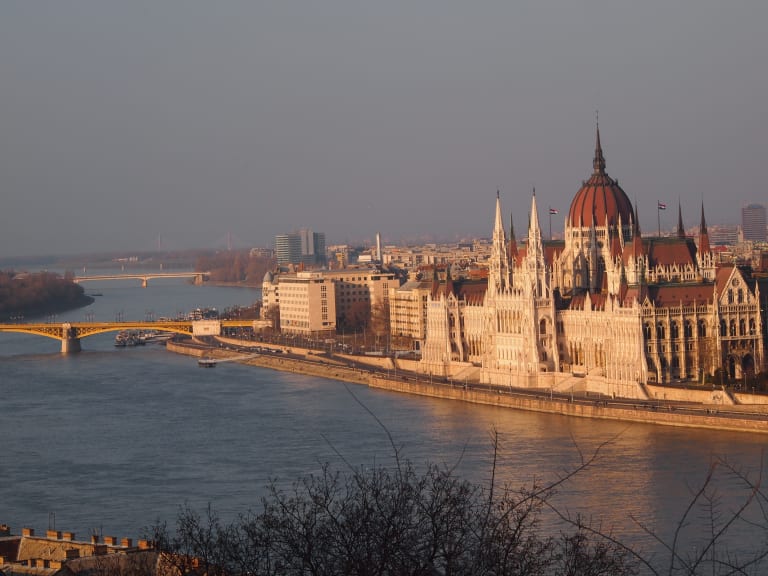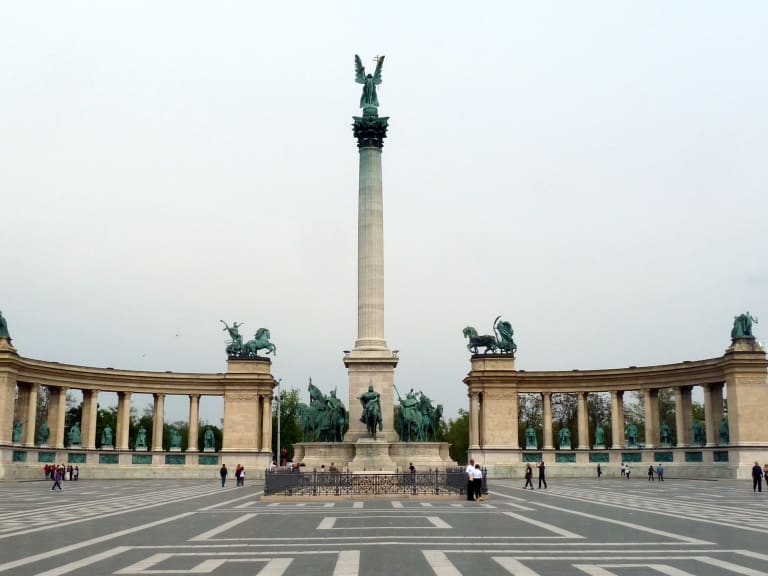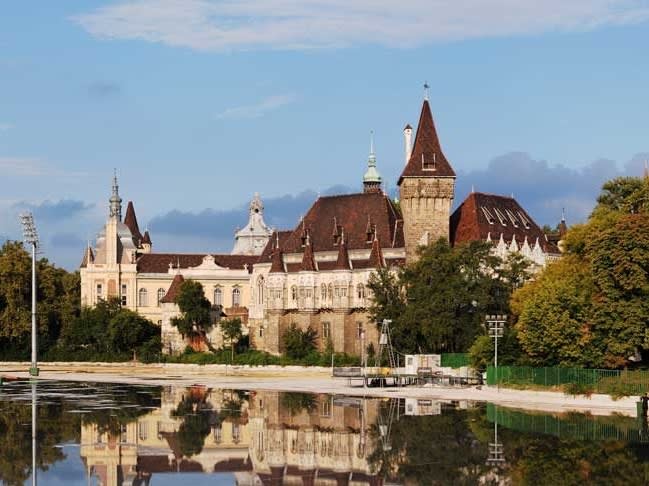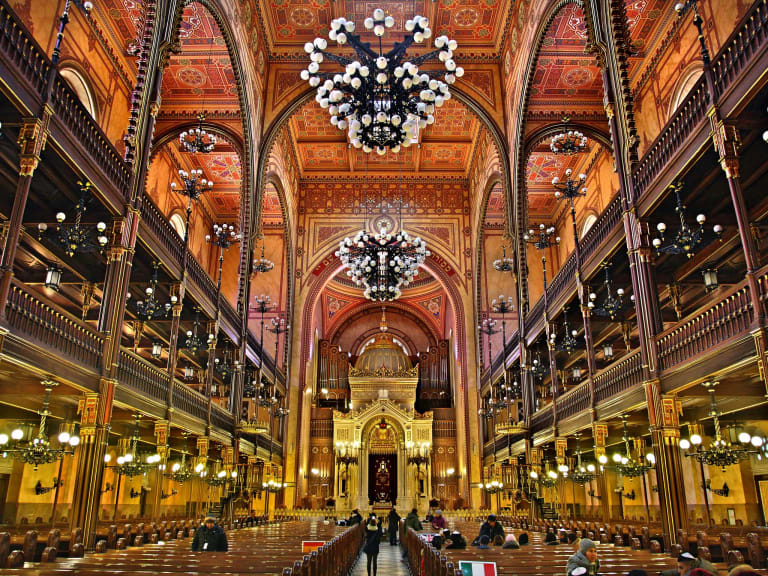Budapest in 5 Days: tips, what to see, and much more
If you are lucky enough to stay in Budapest for 5 days, you will be able to get to know every corner of the Hungarian capital and, in addition, you will be able to go on an excursion.

Budapest sunset | ©Andy Maguire
There is no doubt that there are many things to see and do in Budapest, but those who have 5 days to visit will not miss any of them. During your stay you will be able to see its palaces, churches, ruin bars, the attractions hidden in the Jewish quarter and even take a short cruise on the Danube and spend a few hours in a spa.
Budapest offers its visitors history and beauty in equal parts. In this tour I have prepared for you, you will find all the information you need to enjoy this fantastic city.
Day 1: Explore Pest and visit the Parliament

The first day in Budapest will be dedicated to one of the two main areas in which the city is divided: Pest. If you prefer, you can book a guided tour of Budapest for your first visit, as the city offers both walking and cycling tours of Budapest.
These first few hours in the city will not only help you to see some of the must-see monuments and streets, but also to find out how to get around Budapest, what kind of restaurants there are and the price range.
Marvel at the Parliament building
One of the must-see sights in Budapest is the fabulous Parliament building. Built between 1884 and 1902, it was once the largest building in the world. It has 691 rooms, some of which can be visited, although only on guided tours of the Parliament.
This guided tour will take about an hour, to which you must add the time it takes before entering to comply with all the security measures and to form groups. Its main attractions are as follows:
- Main staircase: this is the first impression you will have of Parliament, and I assure you that you will not be disappointed.
- Dome Hall: it is located inside the dome and it contains several statues of the kings of the country. The most popular is that of St. Stephen, whose crown can also be seen in the same room.
- Former Upper House: although today it is not used for political activity, its structure is still that of a parliamentary chamber.
Climb up the tower of St. Stephen's Basilica
When you finish your visit to the Parliament, I recommend a leisurely stroll through the streets of Pest towards St. Stephen's Basilica, easily recognisable by its tall towers.
This church is the largest church in the country and can hold an estimated 8,500 people. Admission is free, although you will have to pay a small fee to see the Treasury and the Dome. In addition to seeing the interior decoration, as well as the mummified hand of Saint Stephen in the chapel, it is essential that you go up one of the towers (by lift) to get some great views of the city.
And, of course, you can also make the most of your visit and see an organ concert at St. Stephen's Basilica in Budapest.
Take a leisurely stroll along Andrassy Avenue

The next point of interest on the itinerary is Andrassy Avenue. It is lined with impressive Renaissance buildings and palaces, which earned it the UNESCO World Heritage designation in 2002.
Two of the places not to be missed on this walk are the Deschler Palace and the Opera House. The latter can be visited with a guide if you are interested.
Grab a bite to eat at Frici Papa, a city classic
Although you are going to have to take a little detour (nothing serious since the area is really striking) I recommend that you have your first meal at Frici Papa, located at Kiraly utca 55.
Although it's usually full of tourists, the prices are really reasonable, with a set menu for just €5. A half-litre beer will set you back about €1.5.
Joaquin's Traveller Tip
Be wary of ordering too much, as the portions in Budapest are really generous.
Stroll all the way to Elisabeth Ter Park
Walk down Kiraly Utca towards the river and see some interesting churches (as well as a Hindu temple) on this street lined with shops and restaurants.
In Elisabeth Ter Park you'll find a Ferris wheel with a breathtaking view of the city, as well as the Metro museum and a curious corner dedicated to the memory of Michael Jackson.
When you've finished seeing the park you can head to nearby Vorosmarty Ter, one of the city's most important squares. If you feel like it, you can pop into the Gerbeaud's patisserie to try one of their famous ice creams.
Take a ride along the banks of the Danube

Almost at the end of the day, a good idea would be to go to the Danube riverbank and walk along it calmly enjoying the wonderful views of the Buda Castle that you can see from there.
During this walk you will pass by the famous Chain Bridge, where you can look out to see the Danube flowing by. If you go to Budapest in winter, as I once did, you may come across the fabulous sight of a river full of ice blocks crashing against the bridge pillars.
Meditate in front of the Shoe Monument
Before retiring for lunch, the tour takes you to one of the city's most powerful monuments. At first glance, these are just small statues of shoes placed by the river. However, if you know the history it is intended to commemorate, the feeling will certainly change.
This monument was erected in memory of the many Jews murdered during the Second World War. The Nazi practice was to tie up the Jews in the ghetto in pairs and shoot one of them before throwing them into the river. The shoes are therefore a memorial to those executed in cold blood.
Dinner at Hungarikum Bisztro to end the day
After a busy day, there's nothing better than a leisurely dinner at one of the city's best-known restaurants: the Hungarikum Bisztro.
Just 500 metres from the Parliament, this restaurant offers quality traditional food in a great atmosphere.
Day 2: Discover the Buda district, from the castle to the labyrinth.

The other major part of the city, Buda, offers a wealth of attractions for any visitor. Although the highlight is the castle, the neighbourhood around it is worth spending several hours looking at its beautiful historic houses and churches.
If you prefer to be accompanied by a guide you can choose from several tours of the Buda Castle and its neighbourhood. This option has the advantage of getting to know the history of each of the interesting places in the area and, in addition, you can always extend the visit afterwards so that you don't leave anything unseen to your liking.
Start the day in Szent Gellért
Crossing the Freedom Bridge (the one next to the Central Market) you will see the Szent Gellért spa. You can also get here by metro, as there is a stop right next to it with the same name.
Although it is worth seeing the façade of the spa, this time it will only serve as a reference to start the tour.
Be amazed by the Rupestrian church
Much of Mount Gellért, very close to the spa, is hollowed out by a series of tunnels caused by the action of the thermal waters that flowed through it.
This erosion led to the creation of several rooms, including the one that was converted into the so-called cave church. Here you can see a painting of Saint Kolbe, a Polish monk who tried to save several prisoners from the Auschwitz concentration camp. In addition, you can also see a reproduction of the Black Madonna of Czestochowa (Poland).
The entrance to this church is completely free and it can be accessed from Monday to Saturday between 9:30 am and 7:30 pm.
Visit Buda Castle

From the Rupestrian Church, walk along the banks of the Danube for a few minutes before starting to climb up to the castle. On the way up you will be able to see the monument to Szent Gellért (St. Gerard), a bronze statue located where he is said to have suffered his martyrdom.
To climb the hill on which Buda Castle is situated you can choose between taking a funicular or going up the slopes leading up to the area.
Buda Castle, also called the Royal Palace because it was the residence of the Hungarian kings, consists of a large central courtyard, several remnants of the walls, a beautiful neo-Gothic fountain, gardens and a large building divided into three wings. These house the Széchenyi Library, the Hungarian National Gallery and the Budapest History Museum. Entry to the complex is free, but there is a charge to visit the museums. They are usually open between 10am and 6pm, with the exception of Mondays, when they are closed.
Don't miss the Fishermen's Bastion
After seeing the castle in depth (entering or not the museums depending on your interests), it's time to visit one of the most impressive sights in Budapest: the Fisherman's Bastion.
The Bastion dates back to 1905 and was named after the part of the city walls that was defended by fishermen in the Middle Ages. From here you can see possibly the best panoramic view of the whole city, with the Danube at your feet, the Chain Bridge to the right and the Parliament in the background.
The seven towers of the monument represent the chiefs of the Magyar tribes. If you enter the walled enclosure you will find a palace, a castle and the sensational Matthias Church.
If you feel like it, there are several restaurants in the area where you can get something to eat. Be warned that they tend to be a bit pricey, but you will also find some fast food chains nearby that can be useful for this occasion.
Joaquin's Traveller Tip
I recommend that you try to see the Bastion lit up at night, as it takes on a beautiful reddish colour.
Enter the Matthias Church

The Matthias Church is another must-see when you are in the Buda area. Its name is actually the Church of Our Lady, but it is better known by the name of the Hungarian King Matthias, one of the country's heroes.
Many royal weddings were held here, as well as several coronations. The latter explains why there is a copy of the crown there.
There is a fee to enter the church, but there are two different types of entrance. One, the simpler one (around €5) is to enter the church itself, while the other (the same price) is required to go up to the tower.
Try not to get lost in the Buda Labyrinth
The Buda quarter still has other charms to show off. If you stroll through its streets you'll come to the Buda Labyrinth, a series of grottoes that have been made accessible to visitors, although only a little over 1 kilometre of the estimated 7 kilometres.
Once inside the labyrinth you'll be able to see a great number of things: fountains, columns, cave paintings, statues, etc.
If you have the chance, try to visit this place from 18:00 onwards. At that time the lights are usually turned off completely and the visit is done with oil lamps.
Joaquin's Traveller Tip
If you like depths and history, not too far away you will find a former underground hospital that was converted into a nuclear bunker at the end of World War II and during the Cold War. A truly impressive visit.
Walk to the river and photo in front of the Parliament
The last walk of the day should take you through the streets of the neighbourhood to the river. Although you will have to walk a little further to cross one of the bridges, I advise you to walk until you are right in front of the Parliament.
The view of this building, especially at night with the lighting, on the other side of the Danube is one of the best photos you can take.
After this, all you have to do is head back to your hotel and look for a place to have dinner and relax after a tiring day.
Day 3: A more relaxed tour with a grand finale

For the third day in Budapest I have prepared a much more relaxed tour for you so that you can recover your strength after the first two days.
A large park and a final surprise are the highlights of the day. Don't forget to take a swimming costume before leaving the hotel.
See the monuments at Heroes' Square
To start the day you have to return to Andrassy Avenue, but with the intention of walking towards the north. A good way to get there is by metro, as the line that passes under this avenue is the second oldest in the world and is well worth a visit. Once in Andrassy, walk in the opposite direction to the river, an area with fewer historic buildings, but with many embassies. At the end of the street is Heroes' Square, one of the most important squares in the city.
In the square you can see the impressive Millennium Monument. It depicts the seven Magyar tribes that founded the country. Don't miss two neoclassical buildings located in the same square: the Palace of Art and the Budapest Museum of Fine Arts. My advice, moreover, is to go inside the latter and spend some time there.
Inside you can see works by renowned painters such as El Greco, Picasso, Raphael and Cézanne. It is also worth noting its classical art rooms, with various objects from Greece, Rome and Egypt, including some mummies. The entrance fee is less than 9 € and if you have the Budapest Card you will get a 10% discount.
Lose yourself in the City Park
Behind the square is the City Park, whose beauty is enhanced by the castle inside.
Originally, this park was conceived as a hunting ground for the nobility, but from the 18th century onwards it was transformed into what it is today: one of the meeting points for the city's inhabitants when they want to take a walk with the family.
Its large dimensions, 1,400 by 900 metres, make this green area one of the city's recreational areas. Inside there is a lake where you can rent a boat or go ice skating, depending on the time of year you have travelled.
Take some time to visit the small Vajdahunyad Castle and its church

Still within the park is Vajdahunyad Castle, a building constructed for the 1896 Expo. At that time, the castle was built of wood, the same design was repeated in stone, which is how it can be seen today. Parts of it were copied from other buildings in various parts of Hungary, but the whole is quite homogeneous. If you can, climb one of the towers to get a view of the whole area.
Inside the castle you can also visit a museum dedicated to agriculture, as well as a very small but beautiful church.
When you have finished touring the castle and visiting its attractions, I recommend that you buy some food at one of the kiosks that are usually found in the area and that you sit down on a bench in the park to have a quiet meal before continuing.
Relax at the Széchenyi Spa
The big surprise inside the City Park is undoubtedly the presence of one of the best spas in Budapest: the Széchenyi Spa. My suggestion is that you enter and relax to your heart's content in what is one of the city's great attractions.
You can stay as long as you like in this spa. With its 18 pools, both indoor and outdoor, it is the largest establishment of its kind in the city. All of these pools are filled with spring water and the place also has several steam rooms and saunas located under Baroque-style domes.
End the day with a dinner cruise on the Danube
To end the day, after spending a few hours at the spa, there is no better plan than heading to the river for a dinner cruise.
From the boat you will be able to admire the main monuments of the city from a different point of view. And while the live music plays, you can enjoy a fabulous dinner accompanied by local wine.
Day 4: Excursion to the Balaton Lake

One of the advantages of having so many days to visit Budapest is that you have the option of doing some interesting excursions in the surrounding area. Although you can choose between several (such as going to Gödöllo Palace, Lake Balaton and Herend or going to Vienna from Budapest), this time I suggest you to go to one of the most visited places in the country: Lake Balaton.
Lake Balaton
Many consider this lake to be a real inland sea in Hungary. Located about 100 kilometres from the capital, it is the largest freshwater lake in Central Europe.
On this day trip you will have the opportunity to comfortably explore the area around the lake, on the shores of which there are several towns with a rich cultural and leisure heritage.
Tihany Abbey
One of the most interesting stops on this tour is Tihany Abbey, located in the village of the same name. Founded as a Benedictine monastery in 1055, a visit to the interior is highly recommended.
The village of Tihany itself is also worth a stroll through its streets, although it cannot compare with the stunning views of Lake Balaton and the natural environment surrounding the abbey.
The spa town of Balatonfüred
No trip to the lake would be complete without a stop in Balatonfüred, Hungary's oldest spa town. Its streets are lined with modern buildings and old palaces where the aristocracy of the Austro-Hungarian Empire used to spend their holidays.
The town is also well known for its thermal spr ings and for its beautiful promenade along the lakeshore.
Day 5: From the Jewish Quarter to the Ruins Bar

On your list of things to see and do in Budapest, I recommend that you save a visit to **Budapest'**s Jewish Quarter for the morning of the last day of your trip. As in other parts of Central and Eastern Europe, during the Second World War its streets were turned into a ghetto and a real concentration camp.
If you want to make this tour more comfortable, you can always hire some of the guided tours of the Jewish quarter. The best thing about this option is having a guide who will explain the history of the area and the Hebrew community that lived here.
Jewish Synagogue
The most interesting place in the neighbourhood is the Jewish Synagogue, the second largest Jewish synagogue in the world after the one in Jerusalem. The building was constructed between 1854 and 1859 in a Moorish style with Byzantine, Romanesque and Gothic influences.
The interior is truly impressive, with some non-traditional elements of Hebrew architecture such as an organ and a Moorish dome. The large cast-iron columns in the women's area are also very interesting.
Next to the synagogue is the Jewish Museum, which is ideal for those who want to learn more about the history of Judaism in the country.
Outside the Synagogue: the Temple of Heroes and the Jewish Cemetery
Next to the synagogue you will also be able to see some elements without which the history of the Jewish community in Budapest would not be understood. One of them is the Temple of Heroes, dedicated to the Jews who died in the First World War. Another is the Jewish Cemetery, which is worth a visit even though it is not as impressive as the one in Prague.
In that part of the neighbourhood you should also look for the so-called Tree of Life. It is a sculpture of a weeping willow tree erected in 1991. On each leaf is written the name of one of the Jewish victims of the Holocaust.
Visit the post the best tours of Budapest's Jewish Quarter and find out everything you need to know about this area of the Hungarian capital.
Take a leisurely stroll through Váci Utca

After visiting the Jewish Quarter it is time to visit the second most important street in the city centre after Andrassy Avenue: Váci Utca. It runs parallel to the Danube and runs from Vörösmarty Square to the Great Central Market.
This street was built in the 18th century and still preserves some mansions from that period. However, almost all of the buildings that can be seen today date from two centuries later.
In its first decades, the street was a meeting place for the city's upper classes, but nowadays it has been filled with souvenir shops, restaurants, cafés and shopping centres. This, however, has not made it lose its charm and it is worth a leisurely stroll. Although you can try to grab a bite to eat here, my advice is to wait until you get to the Central Market.
Budapest Central Market: the city's gastronomic cathedral
It's hard to believe that when the Central Market was built at the end of the 19th century, it provoked protests from many citizens who claimed that prices had risen because of it. It is also hard to believe that this great temple of gastronomy was practically unused for decades after the Second World War, when it was severely damaged.
Today, having been restored between 1991 and 1994, this great building is one of the most visited in the city. In its stalls you will find all the ingredients of Hungarian cuisine, as well as souvenir shops and other items.
On the first floor there are a number of small food st alls where I recommend having lunch. Note that many of them retain the custom of sharing a table with other diners, but this adds to the authenticity of the experience.
Do your final shopping and stroll around
For the rest of the afternoon I recommend a relaxing stroll through the streets of the city centre. Either in Váci Utca, in the Central Market or in the nearby streets you can do your last shopping and stop at one of the wonderful cafés in the area whenever you feel like it.
You can also stroll along the river bank and go to the Chain Bridge to say goodbye until your next visit.
Ruin Bars Route
You can't leave the Hungarian capital without visiting its famous ruin bars, the best places to enjoy Budapest's nightlife.
These places (whose name means "ruin bars") emerged after the fall of the Iron Curtain when groups of young people began to refurbish abandoned buildings to turn them into bars. Many of them are located in the Jewish quarter, now one of the most revitalised parts of the city.
If this is your first time in the city, I recommend you book one of the tours that take you around several ruin bars and include a few drinks. For those who prefer to go on their own, you can read about the best ones in this article.
